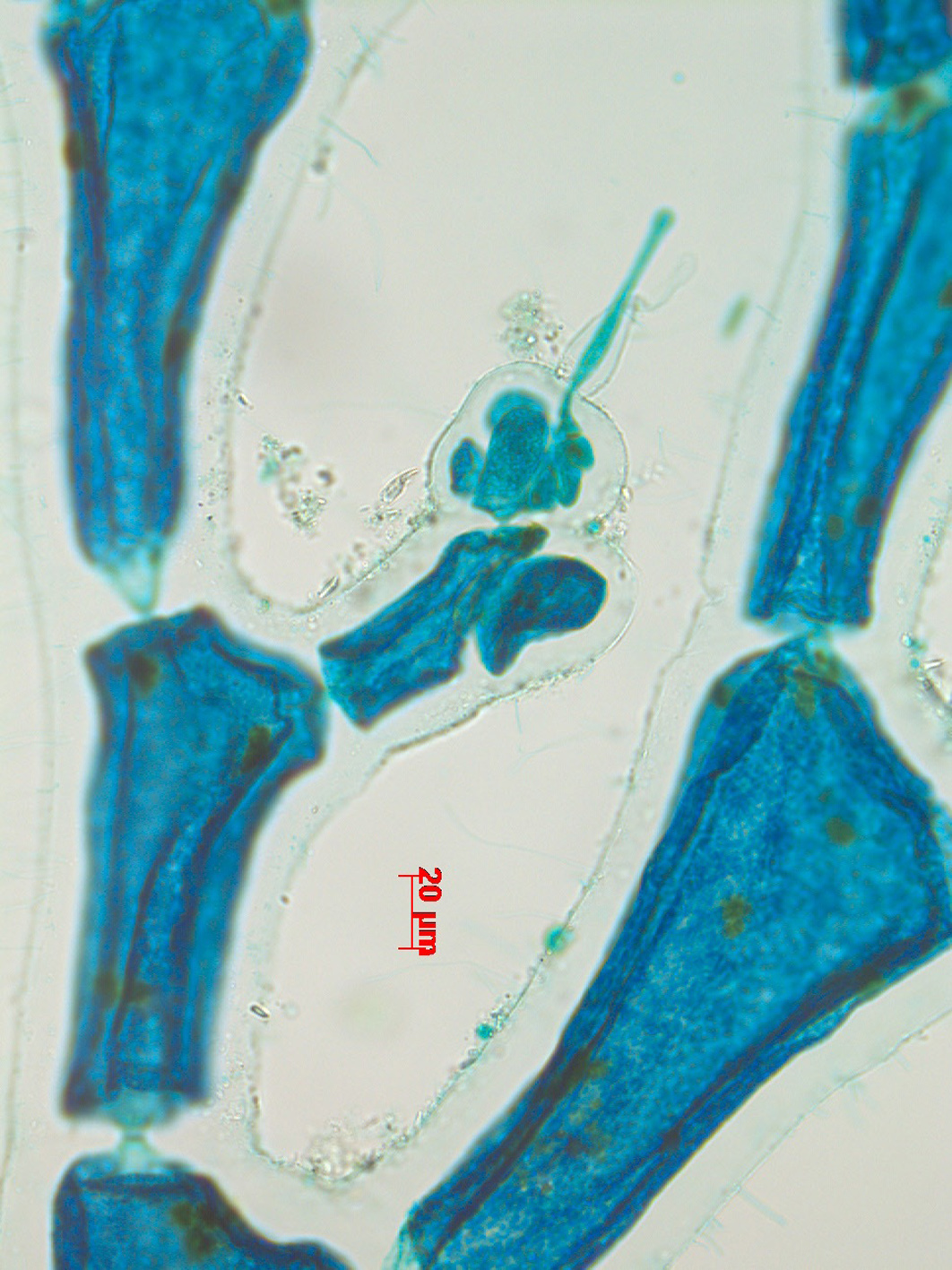Seaweeds of the South African South Coast


Order Ceramiales
Family Wrangeliaceae
Pleonosporium filicinum (Harvey ex J. Agardh) De Toni 1903: 1308
Plants up to 5 (-20) cm tall. Thallus complanate, with a distinct main axis, branched every segment. Branching to the fifth order, axes of all orders strongly flexuose. Main axes up to 350 µm in diameter, the cells up to 1.3 mm long, ecorticate. Terminal cells ca. 55 µm in diameter. Branches are as a rule single, but opposite branches may occur in some older laterals on basal segments.
Polysporangia sessile, usually on the basal cells on several orders of laterals, measuring ca. 125 x 100 µm, containing ca. 32 to 64 spores. Spermatangial heads in terminal position on the branchlets, sometimes becoming subterminal as the bearing cell produces another branchlet. Spermatangial heads short cylindrical, with a four-celled axis (hardly visible in mature heads), measuring ca. 100 x 50 µm. Female fertile filament three-celled, developing in an apical position, the hypogenous cell almost at the same time developing a single involucral filament that branches repeatedly. Full-grown carposporophytes nearly round, ca. 350 µm in diameter, with two or three gonimolobes visible. Carpospores at maturity ca. 50 µm in diameter. In cases where the carpogonium is not fertilized, the hypogenous cell develops a normal vegetative branch and the fertile filament becomes subapical.
Collections, ecology and regional distribution
Recorded from Swartklip (False Bay) to the Durban Area of KwaZulu-Natal (18-51). Found along the whole south coast, not rare; occurring on lifeless substrata or on calcareous algae.
World distribution: Southern African endemic, also found in Namibia (Rull Luch 2002).
Type locality: Muizenberg, Western Cape Province, South Africa (Silva et al. 1996).
Note: A related species, P. paternoster Stegenga, differs mainly by its smaller polysporangia and the possession of six involucral branches around the carposporophytes – it is so far found only in the South-West Cape (Stegenga et al. 1997).

Pleonosporium filicinum. 1 Thallus apex with polysporangia. 2 polysporangia. Reproduced from Stegenga et al. (1997).

Pleonosporium filicinum, thallus apex with polysporangia (stained slide).

Pleonosporium filicinum, polysporangia (stained slide).

Pleonosporium filicinum, carposporophyte (stained slide).

Pleonosporium filicinum, female fertile filament (stained slide).

Pleonosporium filicinum, spermatangial stands (stained slide).
References Pleonosporium filicinum
De Toni, G.B. 1903. Sylloge algarum omnium hucusque cognitarum. Vol. IV. Florideae. Sectio III. pp. [i], frontispiece, [iii-v], 775, 775 bis, 776, 777 bis, 777-1521 + 1523-1525. Patavii [Padua]: Sumptibus auctoris.
Rull Lluch, J. 2002. Marine benthic algae of Namibia. Scientia Marina 66 (Supplement 3): 258 pp.
Silva, P.C., Basson, P.W. & Moe, R.L. 1996. Catalogue of the benthic marine algae of the Indian Ocean. University of California Publications in Botany 79: 1-1259.
Stegenga, H., Bolton, J.J. & R. J. Anderson. 1997. Seaweeds of the South African west coast. Contributions from the Bolus Herbarium 18: 655 pp.
Cite this record as:
Anderson RJ, Stegenga H, Bolton JJ. 2016. Seaweeds of the South African South Coast.
World Wide Web electronic publication, University of Cape Town, http://southafrseaweeds.uct.ac.za; Accessed on 07 January 2026.